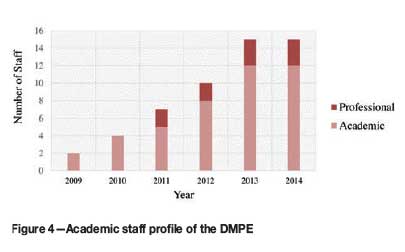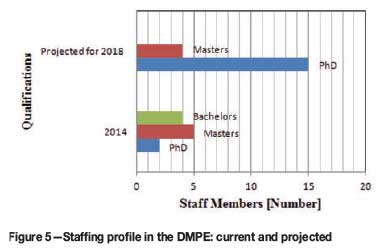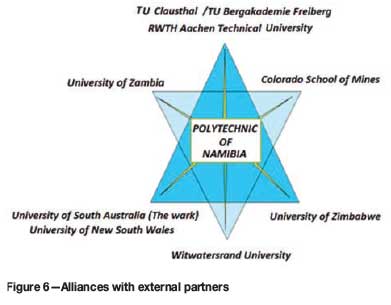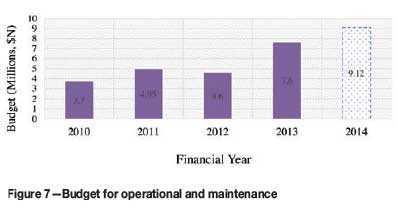Services on Demand
Article
Indicators
Related links
-
 Cited by Google
Cited by Google -
 Similars in Google
Similars in Google
Share
Journal of the Southern African Institute of Mining and Metallurgy
On-line version ISSN 2411-9717
Print version ISSN 2225-6253
J. S. Afr. Inst. Min. Metall. vol.114 n.12 Johannesburg Dec. 2014
A SOUTHERN AFRICAN SILVER ANNIVERSARY MEETING, 2014 SOMP
Interventions for ensuring sustainability of the minerals education programmes at the Polytechnic of Namibia
D. TeshI; H. MusiyariraI; G. DzinomwaII; H. MischoIII
IDepartment of Mining and Process Engineering, Polytechnic of Namibia, Windhoek, Namibia
IIPaasol Resources (Pty) Ltd, Harare, Zimbabwe
IIIDepartment of Mining Engineering, Technical University Bergakademie, Freiberg, Freiberg, Germany
SYNOPSIS
The mining industry worldwide is facing a tremendous shortage of minerals engineers in all fields of specialization. For instance, in Australia the skills shortage in the mining industry has been identified as one of the top risks facing the mining industry. In Namibia most minerals engineers employed are expatriates, with some being Namibians who studied abroad. The minerals engineering programmes at the Polytechnic of Namibia are still in their infancy. These programmes were designed to meet the mining industry skills needs. Being young has its advantages in that lessons can be learnt from older minerals education institutions that went through similar challenges. However, this does not imply just copying and implementing their approaches, since the context differs and, to ensure sustainability of the minerals education programmes, curricula have to be customized to the local context. This paper reviews the interventions made by the Polytechnic of Namibia in order to ensure the sustainability of its minerals education programmes. The methodology consisted of an extensive literature review, a status quo analysis of the mining and process engineering department, identifying the gaps between the current state and desired state, and mapping the goals and strategic actions required to progress to the desired state. The following factors were identified as major threats to the sustainability of minerals education at the Polytechnic of Namibia: the quality of students, low student enrolment rates, low pass rates in science and mathematics, shortage of academic staff, dwindling government funding, and limited involvement of the mining industry. The major outcomes of this research comprise the detailed strategic actions employed by the Polytechnic of Namibia to address the threats to sustainability of its minerals education programmes.
Keywords: mineral eduction, partnerships, Polytechnic of Namibia, sustainability.
Introduction
In the past decade, globalization and fluctuating mineral prices have had a significant impact on the minerals industry and the suppliers and manufacturers that service it. At the same time, the minerals tertiary education institutions in most countries have found themselves battling to be self-sustainable (Phillips, 1999; Galvin and McCarthy, 2001). The sustainability of minerals education is a worldwide problem and not merely limited to Namibia. For instance, in Australia the skills shortage in the mineral industry has been identified as one of the top risks facing the industry (Minerals Council of Australia, 1998; Ernest and Young, 2012). However, in Namibia, the skills shortage of mineral professionals is aggravated by the fact that the Namibian minerals education institutions are still in their infancy, with the first graduates having been produced only at the end of 2013. This means that the Namibian minerals industry recruits most of its skill needs from outside the country. Musiyarira et al. (2013) confirmed that the sustainability of the minerals education programmes in Namibia was a major issue in the country's effort to tackle the skills shortage. This study looks at the status of the minerals engineering programmes and reveals how the Polytechnic of Namibia has been tackling the threats to the sustainability of its minerals education. The overall objective of this study is to analyse the progress, challenges, and lessons learnt and seek ways of addressing the challenges.
Background
The Namibian economy is heavily dependent on the extraction and processing of minerals for export (Namibian Chamber of Mines, 2014). Mining accounts for approximately 11% of the GDP and for more than 50% of foreign exchange earnings (Namibia Statistics Agency, 2013). Namibia is a primary source of gem-quality diamonds and is ranked the fourth-largest producer of uranium in the world. It also produces large quantities of zinc, gold, acid-grade fluorspar, copper, lead, cement, salt, dimension stone, and other minerals (Namibian Chamber of Mines, 2014). The mining industry worldwide is facing a tremendous shortage of minerals engineers in all fields of specialization (Fraser Institute, 2013). In Namibia most mineral engineers employed are expatriates, with some being Namibians who studied abroad (Mischo, 2010). A study by the Namibian Chamber of Mines (2007) revealed that there were shortages of mining and metallurgical engineers in the mining sector. This situation is not unique to Namibia, and Musingwini et al. (2013) made similar observations for the South African mineral industry.
In response to the mining boom, the University of Namibia (UNAM) and Polytechnic of Namibia (PON) introduced minerals engineering degree programmes in 2008/2009 and are in the process of developing professional and further education programmes to meet future mining industry skills needs and build a workforce that incorporates sustainable development into the production environment. In order for minerals engineering education to be sustainable, it is important for Namibia to learn from experience and best practices all over the world. This paper considers the case of the Polytechnic of Namibia which is in the process of transforming into the Namibia University of Science and Technology.
The minerals engineering programmes at the Polytechnic of Namibia are still in their infancy, with the first intake having graduated in October 2013. These programmes were designed to meet the skills needs of the mining industry. The threats to minerals education are generic worldwide, but the solutions have to be context-specific. In a study of the sustainability of minerals education in Namibia, Musiyarira et al. (2013) identified seven interactive factors that may affect the sustainability of minerals education. These are: (1) the funding covering the essential needs of the institutions, (2) matching the number of graduates to the need of the mining and related industries, (3) the quality and quantity of students enrolling for the programmes, (4) alliances and partnerships with other educational institutions, (5) the quality and quantity of academic staff, (6) sound infrastructure, and (7) well-developed and dynamic curricula. It is important to realize that these factors are not unique to the Namibian mineral education system, but they are worldwide trends as noted by other researchers (Cawood, 2011; Galvin and McCarthy, 2001; Moudgil, 2006; Wagner, 1999). The only difference is that all institutions are affected differently and within the context of their development.
Methodology
An extensive literature review was conducted, as well as a status quo analysis of the Mining and Process Engineering Department at the Polytechnic of Namibia, identifying the gaps between current and desired states and mapping the goals and actions requires to progress to the desired state. Reports and documents from various stakeholders were analysed. Comparative studies with established institutions regionally and internationally were conducted in a bid to learn from the experience of others. Since two of the authors are Polytechnic of Namibia staff members and two are visiting academics at the same institution, the data was readily available.
Results and discussion
The following sections detail the strategic actions employed by the Department of Mining and Process Engineering (DMPE) at the Polytechnic of Namibia in tackling the threats to its sustainability. Figure 1 summarizes the elements used in strategies employed by the DMPE to tackle the threats to its sustainability. It can be seen that this is a holistic approach, involving different strategies, all of which are equally important.

Funding covering the essential needs of the institutions
Figure 2 shows the running costs of the department, which include operational, maintenance, and laboratory equipment (2010-2013). The value for 2014 is a projected figure. It can be observed from Figure 2 that the running cost has been increasing steadily each year. However, the authors note with concern that the funding is being threatened by a budget cut from the government.

The quality and quantity of student enrolments for the programmes
Enrolment into the programmes has gradually increased from 2009 to 2013, as shown in Figure 3. However, from 2013 to 2014 the enrolment decreased. This is mainly due to poor matric results, with most of the applicants not meeting the admission requirements. In order to address this challenge, the Polytechnic of Namibia has taken a proactive approach, which includes the establishment of a preparatory year (Pre-Engineering), with the aim of building up the students' skills in the core subjects, namely mathematics, physics, and chemistry. Another strategy employed is to organize schools outreach programmes with the aim of encouraging students to join the local minerals engineering programmes. These outreach trips are complemented by the annual career fairs that are held in March of every year. It was found that most of the best-performing school leavers prefer to study at South African universities, sometimes out of ignorance of what is available in their own country.

Staff development
Staffing levels in the Department of Mining and Process Engineering at the Polytechnic of Namibia have been growing steadily, as shown in Figure 4, but there are still 10 vacancies to be filled. The Department continues to rely on visiting academics in order to meet its teaching needs.

The authors noted that 95% of all the DMPE staff members who are not PhD holders are undertaking studies towards higher qualifications (are enrolled for MSc and PhD degrees); as shown in Figure 5. This will serve to increase the number of permanent academic staff in order to ensure that the programmes are sustainable.

Alliances and partnerships with educational institutions
Alliances with international and regional institutions play an important role in contributing to the sustainability of the DMPE. This has been the case for student and staff (visiting academics) exchange. It is expected that with time the reliance on visiting lecturers will decrease. Figure 6 shows the major partners of the DMPE.

Sound infrastructure
Investment for operations, maintenance, laboratory equipment, and salaries in the Department of Mining and Process Engineering has been increasing steadily, as shown in Figure 7. A five-storey, 200-million Namibian dollar building is being erected, and the DMPE will occupy 40% of the total space. Dedicated laboratories for mining and metallurgy will be set up and equipment is being acquired.

Sound strategic planning and development
The DMPE drafted its strategic plan in 2012. A strategic plan is important since it allows an organization to make fundamental decisions or choices by taking a long-range view of what it hopes to accomplish and how it will do so. This plan reasserts the department's vision, mission, and values and establishes eight strategic goals. The plan recognizes existing strengths - for example, providing a student-centred teaching and learning environment - and seeks to reinforce and develop these qualities. It blends both continuity and change, hence identifying niche areas on which the department needs to concentrate in order to realize its full potential. This plan articulates a course by which the Department of Mining and Process Engineering will build its reputation as a world-class department, dedicated to making a difference in the lives of its staff and students.
Linking staff to companies' needs
For any country to develop technologically and economically there must be a strong link between industry, government, and academic institutions. All courses and programmes offered by such institutions derive their relevance from the needs of the nations they serve, and hence should promote development of existing and future industries. The direction of the research of the DMPE was defined based on a thorough mapping of the Namibian mineral industry. This has the advantage of improving the synergy between the DMPE and the companies within the Namibian mineral industry.
Industrial advisory board
In March 2014, the DMPE set up an industrial advisory board with the primary role of providing strategic direction and advice to the Department. The Advisory Board is expected to have an oversight role in curriculum development as well as in ensuring a strong interaction between the department and the mineral industry. The principle behind the setting up of the board is to involve industry in the value chain for producing 'mineral-industry-ready' graduates. From a quality perspective, process ownership is critical in ensuring good output. This has major advantages for the mining companies since they get the opportunity to mould the quality of output/graduates instead of having to rework the graduates, which is termed 'end-of-pipe panelbeating and entails significant costs. The involvement of the minerals industry as advisors will also allow the timeous provision of feedback to the university for improvement.
International accreditation
Accreditation of engineering programmes is an important component of the sustainability of any teaching programme, as it ensures that the programme is aligned with internationally recognized bodies. It also serves as a quality standard and ensures that engineering graduates will be able to work in any country and not only in their own country. In southern Africa, the most prominent engineering body is the Engineering Council of South Africa (ECSA), which is aligned with the Washington Accord. In 2011 ECSA was requested by the Engineering Council of Namibia (ECN) and the Polytechnic of Namibia to assess the programmes for provisional accreditation of the degree programme in mining engineering. As everywhere else, there were teething problems that could not be overcome in the few years that the department had been in existence. The establishment of the industrial advisory board, the development of the strategic plan, staff development, acquisition of state-of-the-art laboratory equipment, and the expansion of the resource base for the department are some of the efforts to address the concerns raised by the ECSA delegation.
Conclusions
The minerals engineering programmes at the Polytechnic of Namibia are still in their infancy, with the first intake having graduated in October 2013. This study has looked at the status of the minerals engineering programmes and reveals how the Polytechnic of Namibia has been tackling the threats to their sustainability. The major outcomes of this study were the detailed strategic actions taken by the Polytechnic of Namibia to address the threats to the sustainability of its minerals education programmes. The engagement of local and international partners, coupled with the bridging year to ground students in mathematics and science, and staff development, among others, are regarded as being instrumental in ensuring the sustainability of the minerals education programmes at the Polytechnic of Namibia.
References
Cawood, F.T. 2011. Threats to the South African minerals sector-an independent view on the investment environment for mining. Journal of the Southern African Institute of Mining and Metallurgy, vol. 111, no. 12. pp. 469-474. [ Links ]
Chamber of Mines of Namibia. 2007. Skills and Needs Analysis Report. Windhoek. [ Links ]
Chamber of Mines of Namibia. 2012. Annual Review Report 2012. Windhoek. [ Links ]
Ernest and Young. 2012. Business Risks facing Mining and Metals 2012-2013. http://www.ey.com/Publication/vwLUAssets/Business-risk-facing-mining-and-metals-2012-2013/$FILE/Business-risk-facing-mining-and-metals-2012-2013.pdf [Accessed 27 March 2013]. [ Links ] pp. 1-48.
Galvin, J.M. and McCarthy, P.J. Mining education: driven by global impacts. Proceedings of Explo 2001, Hunter Valley, NSW, 28-31 October 2001. Australasian Institute of Mining and Metallurgy, Carlton, South Victoria, Australia. pp. 9-14. [ Links ]
Minerals Council of Australia. 1998. Back from the Brink: Reshaping Minerals Tertiary Education. National Tertiary Education Task Force discussion paper. [ Links ]
Mischo, H. 2010. Bergbaustudium - Aufbau eines Bergbaustudienganges an der Polytechnic of Namibia [Development and Implementation of a new Mining Engineering Programme at the Polytechnic of Namibia]. Gluckauf (Essen), vol. 146, no. 4. pp. 168-173.
Moudgil, B. 2006. An interview with the 2006 SME President. Mining Engineering, vol. 58, no. 3. pp. 32-36. [ Links ]
Musingwini, C., Cruise, J.A., and Phillips, H.R. 2013. A perspective on the supply and utilization of mining graduates in the South African context. Journal of the Southern African Institute of Mining and Metallurgy, vol. 113, no. 3. pp. 235-241. [ Links ]
Musiyarira, H., Tesh, D., and Dzinomwa, G. Challenges of promoting sustainability in the Namibian minerals education. Proceedings of the 6th International Conference on Sustainable Development in the Minerals Industry, Milos Island, Greece, 30 June - 3 July 2013. pp. 25-30. [ Links ]
OECD. 2012. Namibia. OECD Publishing, Paris, France. http://www.oecd.org/countries/namibia/ [Accessed 27 March, [ Links ] 2013]. p. 477.
Phillips, H.R. 1999. Mining education in South Africa - past, present and future. CIM Bulletin, vol. 92, no. 1033. pp. 101-106. [ Links ]
Wagner, H. 1999. How to address the crisis of mining engineering education in the Western World? Mineral Resources Engineering, vol. 8, no. 4. pp. 471-481. [ Links ]














